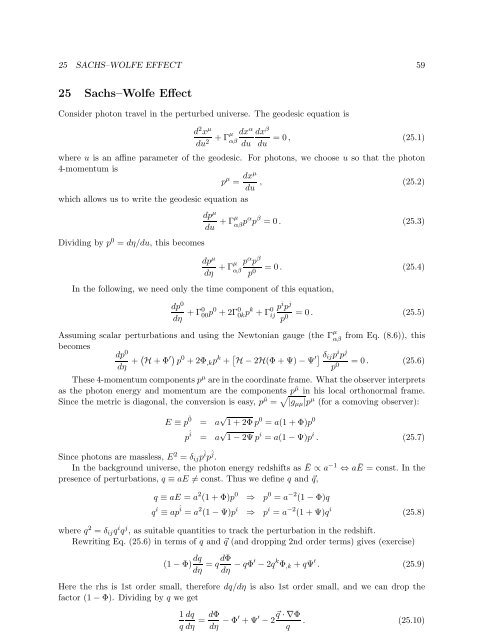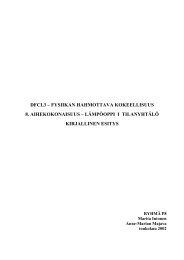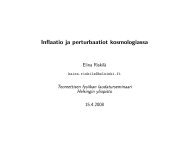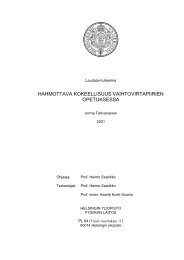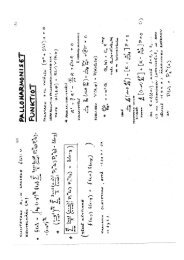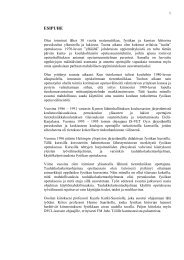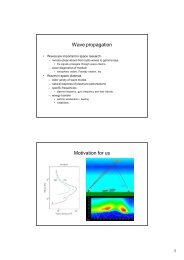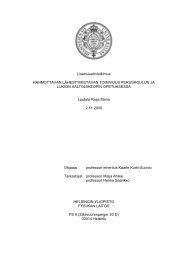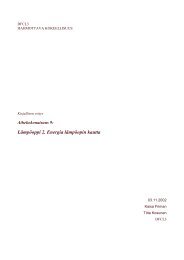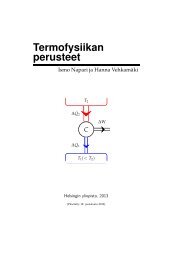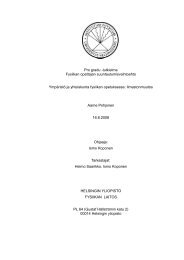Cosmological Perturbation Theory, 26.4.2011 version
Cosmological Perturbation Theory, 26.4.2011 version
Cosmological Perturbation Theory, 26.4.2011 version
You also want an ePaper? Increase the reach of your titles
YUMPU automatically turns print PDFs into web optimized ePapers that Google loves.
25 SACHS–WOLFE EFFECT 5925 Sachs–Wolfe EffectConsider photon travel in the perturbed universe. The geodesic equation isd 2 x µdu 2 + dx α dx βΓµ αβdu du= 0, (25.1)where u is an affine parameter of the geodesic. For photons, we choose u so that the photon4-momentum isp µ = dxµdu , (25.2)which allows us to write the geodesic equation asDividing by p 0 = dη/du, this becomesdp µdu + Γµ αβ pα p β = 0. (25.3)dp µdη + p α p βΓµ αβp 0 = 0. (25.4)In the following, we need only the time component of this equation,dp 0dη + Γ0 00 p0 + 2Γ 0 0k pk + Γ 0 p i p jijp 0 = 0. (25.5)Assuming scalar perturbations and using the Newtonian gauge (the Γ µ αβfrom Eq. (8.6)), thisbecomesdp 0dη + ( H + Φ ′) p 0 + 2Φ ,k p k + [ H − 2H(Φ + Ψ) − Ψ ′] δ ij p i p jp 0 = 0. (25.6)These 4-momentum components p µ are in the coordinate frame. What the observer interpretsas the photon energy and momentum are the components pˆµ in his local orthonormal frame.Since the metric is diagonal, the con<strong>version</strong> is easy, pˆµ = √ |g µµ |p µ (for a comoving observer):E ≡ pˆ0pî= a √ 1 + 2Φ p 0 = a(1 + Φ)p 0= a √ 1 − 2Ψ p i = a(1 − Ψ)p i . (25.7)Since photons are massless, E 2 = δ ij pîpĵ.In the background universe, the photon energy redshifts as Ē ∝ a−1 ⇔ aĒ presence of perturbations, q ≡ aE ≠ const. Thus we define q and ⃗q,= const. In theq ≡ aE = a 2 (1 + Φ)p 0 ⇒ p 0 = a −2 (1 − Φ)qq i ≡ apî = a 2 (1 − Ψ)p i ⇒ p i = a −2 (1 + Ψ)q i (25.8)where q 2 = δ ij q i q j , as suitable quantities to track the perturbation in the redshift.Rewriting Eq. (25.6) in terms of q and ⃗q (and dropping 2nd order terms) gives (exercise)(1 − Φ) dqdη = qdΦ dη − qΦ′ − 2q k Φ ,k + qΨ ′ . (25.9)Here the rhs is 1st order small, therefore dq/dη is also 1st order small, and we can drop thefactor (1 − Φ). Dividing by q we get1 dqq dη = dΦdη − Φ′ + Ψ ′ ⃗q · ∇Φ− 2 . (25.10)q


